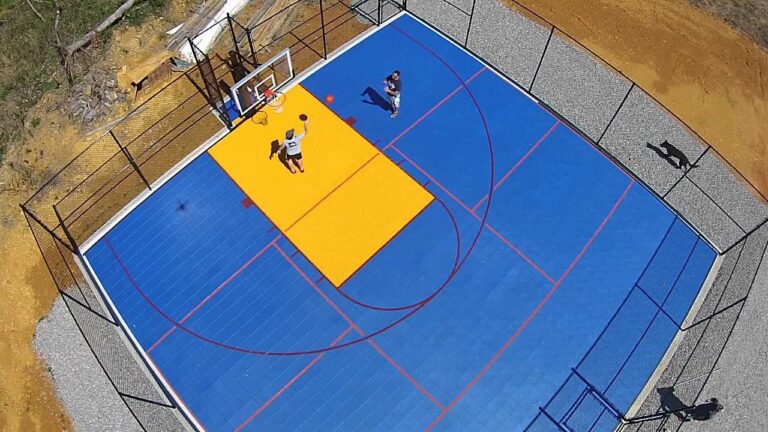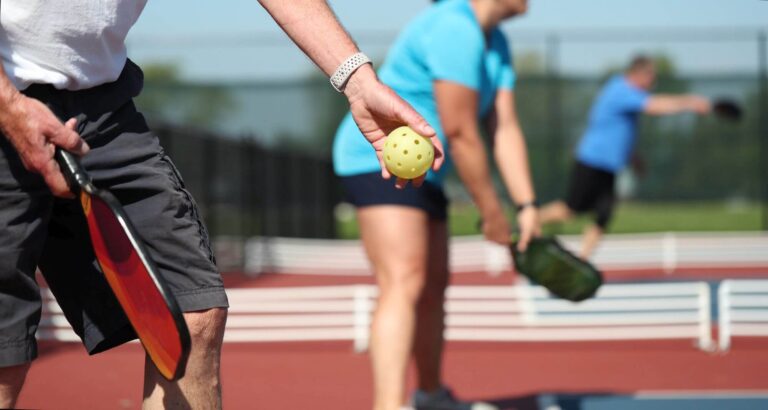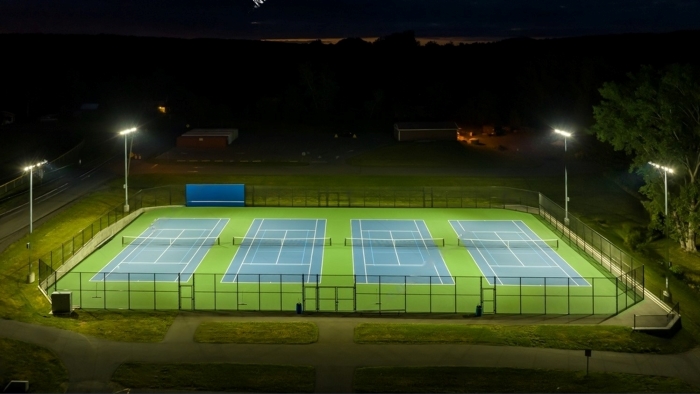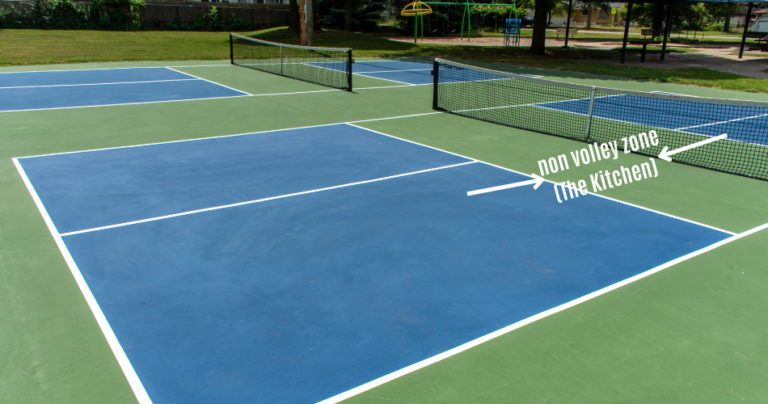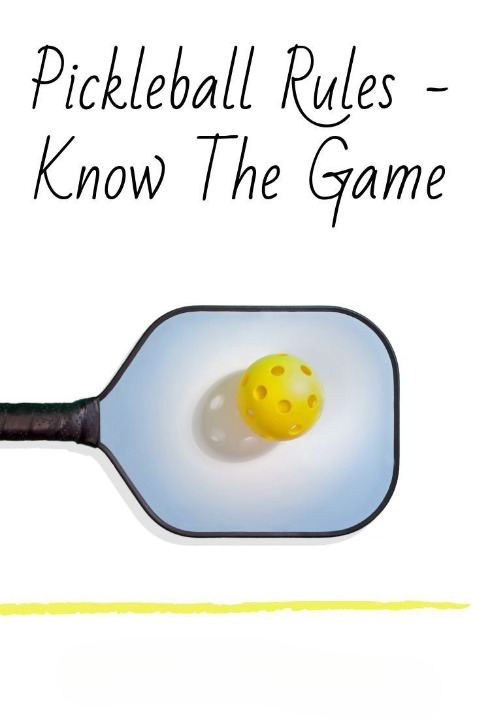Pickleball Kitchen Size: Mastering the Non-Volley Zone for Home Play
What is the Pickleball Kitchen Size? A Complete Guide
The pickleball kitchen size, also known as the non-volley zone, is a crucial area on the court measuring 7 feet deep from the net and spanning the width of the court. Mastering play in the kitchen is essential for any pickleball enthusiast looking to elevate their game. This comprehensive guide explores the official dimensions, rules, and strategies for effective kitchen play, as well as tips for transforming your home kitchen into a functional pickleball court. Whether you’re a beginner or an experienced player, understanding the pickleball kitchen size and its impact on gameplay will help you dominate the court and enjoy the many benefits of this exciting sport.
Key Takeaways
- The pickleball kitchen, also known as the non-volley zone (NVZ), is a crucial area on the pickleball court where players are not allowed to volley the ball.
- The official pickleball kitchen size is 20 feet wide and 7 feet deep, as per USAPA rules, and remains consistent across all skill levels and court surfaces.
- The kitchen size significantly impacts gameplay strategies, player positioning, and the importance of dinking and soft shots.
- Transforming your home kitchen into a pickleball court is possible with creative layouts, portable equipment, and attention to safety.
- Optimizing your pickleball kitchen involves considering factors such as flooring, lighting, noise reduction, and budget-friendly solutions.
- Mastering kitchen play requires practice, patience, and the use of effective strategies like dinking, drop shots, and proper footwork.
- Understanding the pickleball kitchen line and other court markings is essential for proper court setup and adherence to rules.
- Playing pickleball in your kitchen offers numerous benefits, including convenience, practice opportunities, and family bonding.
- Pickleball kitchen etiquette involves respecting your space, establishing clear rules, and being mindful of neighbors.
- Continuously working on your kitchen skills, incorporating drills and exercises, and avoiding common mistakes will help you elevate your pickleball game.
By keeping these key takeaways in mind, you’ll be well-equipped to understand the importance of the pickleball kitchen size, optimize your home setup, and enjoy the many benefits of this exciting sport. Remember, practice makes perfect, so don’t be afraid to spend time in your pickleball kitchen and hone your skills. With dedication and a love for the game, you’ll be a pickleball kitchen master in no time
But first, let’s address the burning question: Can your kitchen accommodate a pickleball court? The answer might surprise you! With a little creativity and some adjustments, transforming your kitchen into a pickleball haven is possible. So, grab your paddles, and let’s explore the world of pickleball kitchen size. Know Places to Play
What is the Pickleball Kitchen?
The pickleball kitchen, also known as the non-volley zone (NVZ), is a critical area on the pickleball court. Located on both sides of the net, the kitchen extends 7 feet back from the net and spans the width of the court. This area is where players are not allowed to volley the ball, meaning they cannot hit the ball out of the air without letting it bounce first.
The kitchen plays a significant role in pickleball gameplay, as it encourages players to engage in strategic rallies and dinking (soft, short shots) rather than relying solely on power plays. Mastering the art of playing in the kitchen is essential for any pickleball enthusiast looking to elevate their game.
| Pickleball Kitchen Terms | Definition |
|---|---|
| Non-Volley Zone (NVZ) | The official term for the pickleball kitchen, where volleys are not allowed. |
| Dinking | A soft, short shot that lands in the opponent’s kitchen, designed to force them to hit up and allow you to control the point. |
| Foot Fault | A violation that occurs when a player steps into the kitchen while volleying the ball or touches the kitchen line during a volley. |
| Volley | Hitting the ball out of the air before it bounces. |
Pickleball Kitchen Size Dimensions
According to the USA Pickleball Association (USAPA) rules, the official pickleball kitchen size is as follows:
- Width: 20 feet (6.10 meters)
- Depth: 7 feet (2.13 meters)
These dimensions apply to both singles and doubles play. It’s important to note that the kitchen size remains constant regardless of the court surface (indoor or outdoor) or the skill level of the players. want to How to Serve in Pickleball ?
To put the pickleball kitchen size into perspective, let’s compare it to the kitchen sizes in other racquet sports:
- Tennis: The tennis non-volley zone, called the service box, is 21 feet (6.40 meters) wide and extends 18 feet (5.49 meters) from the net.
- Badminton: There is no designated non-volley zone in badminton.
Now, the million-dollar question: Is your kitchen big enough for pickleball? Let’s break it down:
Standard Pickleball Court Dimensions
- Singles: 20 feet (6.10 meters) wide and 44 feet (13.41 meters) long
- Doubles: 20 feet (6.10 meters) wide and 44 feet (13.41 meters) long
Pickleball Kitchen Size Requirements
- Minimum: 20 feet (6.10 meters) wide and 7 feet (2.13 meters) deep
- Recommended: Allow an additional 5-6 feet (1.52-1.83 meters) on each side for comfortable play and movement.
To determine if your kitchen can accommodate a pickleball court, follow these steps:
- Measure the length and width of your kitchen.
- Compare your measurements to the minimum pickleball kitchen size requirements.
- If your kitchen meets or exceeds the minimum requirements, you can proceed with setting up your court.
- If your kitchen is smaller than the minimum requirements, consider alternative spaces or adjustments to make pickleball play possible.
Keep in mind that while you might be able to squeeze in a singles court, doubles play may require more room for comfortable movement and safety.
Singles vs. Doubles Pickleball in the Kitchen
- Singles: Playing singles pickleball in your kitchen is more feasible due to the smaller court size and fewer players.
- Doubles: For comfortable doubles play, you’ll need a larger kitchen or may need to consider alternative spaces like a garage or backyard.
Why is the Pickleball Kitchen Size Important?
The pickleball kitchen size has a significant impact on gameplay strategies and player positioning. The non-volley zone rules dictate that players cannot volley the ball while standing in the kitchen, forcing them to let the ball bounce before hitting it. This rule encourages longer rallies and places emphasis on precision and finesse rather than raw power.
The kitchen size also affects different skill levels and playing styles:
| Skill Level | Kitchen Impact |
|---|---|
| Beginners | Often drawn to the kitchen for safer, shorter shots and dinking rallies. |
| Intermediate | Learn to navigate the kitchen more effectively, using a mix of drop shots, lobs, and strategic positioning. |
| Advanced | Master the art of kitchen play, utilizing precise shots, deception, and court coverage to outmaneuver opponents. |
In doubles play, the pickleball kitchen size becomes even more crucial:
- Partners must communicate and coordinate their movements to cover the kitchen area effectively.
- Players need to avoid collisions and ensure that at least one player is always ready to respond to the opponent’s shots.
- Effective kitchen play in doubles requires a balance of offensive and defensive strategies, with both players working together seamlessly.
Making the Most of Your Pickleball Kitchen (Optimizing Space)
If your kitchen is on the smaller side, don’t worry! With a few adjustments and creative solutions, you can still enjoy pickleball in the comfort of your home.
Pickleball Kitchen Size with Adjustments (For Smaller Kitchens)
- Consider using a portable net that can be easily set up and removed as needed.
- Opt for a smaller, compact pickleball set that includes paddles and balls designed for limited space play.
- Use tape or removable court lines to mark the kitchen and court boundaries.
Creative Court Layouts for Non-Standard Kitchens
- Diagonal layout: Set up the court diagonally across your kitchen to maximize space.
- L-shaped layout: Utilize an L-shaped area of your kitchen, using the countertops as natural boundaries.
- Multi-room layout: Extend the court into an adjacent room, like a dining room or living room, to create a larger playing area.
Pickleball Kitchen Equipment (Portable nets, paddles)
To fully equip your pickleball kitchen, consider investing in the following:
| Equipment | Description |
|---|---|
| Portable pickleball net | Look for a net that is easy to set up, sturdy, and comes with a carrying case for storage. |
| Pickleball paddles | Choose paddles that are lightweight, comfortable to grip, and suitable for your skill level. |
| Pickleball balls | Select balls that are specifically designed for indoor play, as they are typically softer and less bouncy than outdoor balls. |
Safety First in Your Pickleball Kitchen
When playing pickleball in your kitchen, safety should be your top priority. Consider the following:
- Clear the area of any obstacles or hazards, such as kitchen appliances, sharp corners, or loose rugs.
- Use padding or protective covers on walls and surfaces to prevent damage and reduce the risk of injury.
- Choose softer, indoor pickleball balls to minimize the impact on surfaces and players.
Additional Considerations for Your Pickleball Kitchen
Beyond the pickleball kitchen size and layout, there are several other factors to consider when setting up your home court:
Pickleball Kitchen Flooring (Suitable Options for Kitchens)
- Hardwood: Hardwood floors provide a smooth, even surface for pickleball play, but may require protective mats to prevent damage.
- Tile: Tile floors offer good traction and durability, but the grout lines can affect ball bounce and movement.
- Linoleum or vinyl: These materials provide a smooth, consistent surface and are easy to clean, making them a popular choice for pickleball kitchens.
Lighting Considerations for Pickleball in the Kitchen
- Ensure your kitchen has adequate lighting for safe and comfortable play.
- Consider installing additional lighting fixtures or using portable lamps to illuminate the court area evenly.
- Opt for LED bulbs or natural light sources to reduce glare and eye strain.
Noise Reduction Strategies for Kitchen Pickleball
- Use softer, indoor pickleball balls to minimize the noise generated during play.
- Apply sound-absorbing materials, such as curtains or acoustic panels, to walls and surfaces to reduce echo and noise transmission.
- Communicate with your neighbors about your pickleball activities and establish agreeable play times to minimize disturbance.
Pickleball Kitchen Conversion on a Budget
Transforming your kitchen into a pickleball court doesn’t have to break the bank. Here are some cost-effective solutions:
| Budget-Friendly Solutions | Description |
|---|---|
| Basic, portable pickleball net | Opt for a simple, portable net rather than a permanent installation. |
| Household items for court lines | Use tape or chalk to create court lines instead of purchasing specialized court marking kits. |
| Repurposed furniture or cushions | Utilize old furniture or cushions as makeshift padding for walls and surfaces. |
The Fun Begins: Pickleball Games in Your Kitchen!
With your pickleball kitchen set up and ready to go, it’s time to enjoy the many benefits of playing pickleball at home:
Benefits of Playing Pickleball at Home (Convenience, Practice)
- Convenience: No need to travel to a pickleball court or wait for an available time slot.
- Practice: Having a home court allows you to practice and refine your skills at your own pace.
- Bonding: Playing pickleball in your kitchen is a great way to bond with family and friends while staying active.
Warming Up Exercises Before Kitchen Pickleball
Before diving into a game, it’s essential to warm up your muscles to prevent injury and improve performance. Try these simple exercises:
- Arm circles: Rotate your arms in forward and backward circles to loosen up your shoulders and upper body.
- Leg swings: Hold onto a chair or countertop for balance and swing your legs forward and backward to activate your lower body muscles.
- Wrist rotations: Rotate your wrists in clockwise and counterclockwise motions to prepare for paddle grip and control.
Pickleball Kitchen Game Variations (Singles Drills, Doubles Games)
Keep your pickleball kitchen sessions exciting and challenging by incorporating different game variations:
- Singles drills: Practice your dinking, volleys, and footwork with solo drills like the “dink and shuffle” or the “figure 8 drill.”
- Doubles games: Invite friends or family members to join in on the fun with doubles games like “skinny singles” or “around the world.”
Pickleball Kitchen Etiquette (Respecting Your Space and Neighbors)
When playing pickleball in your kitchen, it’s crucial to be mindful of your space and neighbors:
- Keep noise levels reasonable, especially during early morning or late evening hours.
- Establish clear guidelines and rules for pickleball play in your kitchen to avoid conflicts and ensure fair play.
- Inform your neighbors about your pickleball activities and address any concerns they may have promptly and respectfully.
Pickleball Kitchen Line and Markings
To ensure your pickleball kitchen is properly set up, pay close attention to the kitchen line and other court markings:
Description of the Kitchen Line (Non-Volley Line)
- The kitchen line, also known as the non-volley line, is a crucial marking on the pickleball court.
- It is typically made of a thin, durable material like vinyl or plastic tape.
- The kitchen line is usually a contrasting color to the court surface, such as white on a dark floor or black on a light surface.
Thickness and Placement of the Kitchen Line
- The kitchen line should be 2 inches (5.08 cm) wide and extend the full width of the court.
- It is placed parallel to the net and 7 feet (2.13 meters) away from it on both sides.
Other Important Pickleball Court Markings Related to the Kitchen
- Sidelines: The sidelines run perpendicular to the net and define the width of the court.
- Baselines: The baselines are located at the rear of the court and mark the end of the playing area.
- Center line: The center line divides the court into right and left service courts and extends from the non-volley line to the baseline.
| Court Marking | Description |
|---|---|
| Kitchen Line (Non-Volley Line) | A line parallel to the net, 7 feet away, marking the non-volley zone. |
| Sidelines | Lines perpendicular to the net, defining the width of the court. |
| Baselines | Lines at the rear of the court, marking the end of the playing area. |
| Center Line | A line dividing the court into right and left service courts, extending from the non-volley line to the baseline. |
Common Questions about Pickleball Kitchen Size
Is the kitchen size the same for indoor and outdoor pickleball courts?
Yes, the pickleball kitchen size is consistent across both indoor and outdoor courts, as per the official USAPA rules.
Can the kitchen size vary in recreational or non-standard pickleball courts?
While recreational or non-standard courts may have slight variations in size, it is recommended to adhere to the official kitchen dimensions for the most authentic pickleball experience.
How does the kitchen size compare to the overall pickleball court dimensions?
The kitchen size (20′ x 7′) is a significant portion of the overall pickleball court dimensions (20′ x 44′), emphasizing its importance in gameplay.
Are there any exceptions to the non-volley zone rules?
The non-volley zone rules are strictly enforced, and there are no exceptions. Players must allow the ball to bounce before hitting it while standing in the kitchen.
Tips for Playing in the Pickleball Kitchen
To elevate your pickleball game and master the art of playing in the kitchen, consider these tips:
Strategies for Effective Kitchen Play
- Dinking: Master the soft, short shots that land in your opponent’s kitchen, forcing them to hit up and allowing you to control the point.
- Drop shots: Utilize drop shots to move your opponent out of position and create opportunities for offensive plays.
- Patience: Avoid rushing your shots or attempting risky volleys in the kitchen. Wait for the right moment to attack or force your opponent into making an error.
Drills and Exercises to Improve Kitchen Skills
- Dink rallies: Practice continuous dinking with a partner, focusing on control, accuracy, and consistency.
- Volley-to-dink transitions: Work on transitioning from volleys to dinks smoothly and efficiently to maintain control in the kitchen.
- Kitchen footwork: Incorporate lateral shuffles, split steps, and crossover steps into your practice sessions to improve your movement and positioning in the kitchen.
Common Mistakes to Avoid When Playing in the Kitchen
- Rushing shots: Take your time and wait for the right opportunity to hit a well-placed shot rather than rushing and making unforced errors.
- Overextending: Avoid reaching too far for shots, as this can throw off your balance and lead to weak returns or errors.
- Crowding the non-volley line: Give yourself some space from the non-volley line to allow for better reaction time and shot selection.
Conclusion
Understanding the pickleball kitchen size and its impact on gameplay is essential for any pickleball enthusiast, whether you’re a beginner or an experienced player. By familiarizing yourself with the kitchen dimensions, rules, and strategies, you can elevate your game and enjoy the many benefits of this exciting sport.
Transforming your kitchen into a pickleball court is not only possible but also a fantastic way to bring the joy of pickleball into your home. With creative solutions, proper equipment, and attention to safety, you can create a fun and functional pickleball kitchen that the whole family can enjoy.
Remember, the key to success in pickleball is practice, patience, and a willingness to learn. By incorporating the tips and drills discussed in this guide, you’ll be well on your way to mastering the art of playing in the kitchen and dominating the pickleball court.
So, what are you waiting for? Grab your paddles, invite some friends, and let the pickleball kitchen adventures begin! Don’t forget to share your experiences, successes, and challenges with the pickleball community – we can’t wait to hear about your journey.
Happy pickling!

